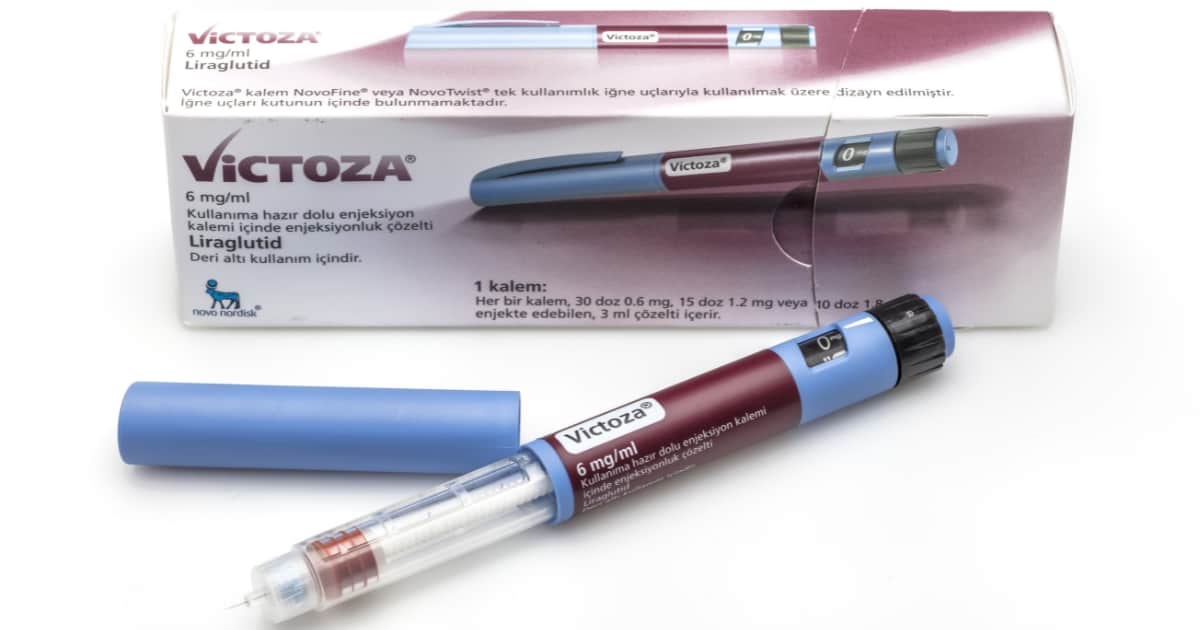Victoza is an injectable medication taken once daily for the management of blood sugar in people with type 2 diabetes.
It helps people achieve lower blood sugar and A1c levels (a measure of glucose control over the previous 2 to 3 months), and even lose weight.
Figuring out the right dose of Victoza for you can take time and should only be done under the guidance of your doctor.

Key Facts
- Victoza is initially prescribed at a low dose of 0.6 milligrams (mg) daily to minimize side effects, with potential adjustments based on individual health needs and tolerance.
- For most people, the maintenance dose is typically 1.2 mg daily, potentially increasing to 1.8 mg for improved blood sugar management, under medical supervision.
- Users may experience side effects like nausea or vomiting. Dosage adjustments should only be made under the guidance of a healthcare provider.
- While not approved for weight loss, Victoza can lead to weight reduction as a secondary benefit. The maximum recommended daily dose is 1.8 mg.
Table of Contents
- What dose do you typically start with?
- What is a normal Victoza dose?
- How and when can you increase your dose?
- What is the correct dose for me?
- What is the correct dose for weight loss?
- What happens if I stop taking Victoza?
- Are there different Victoza pens?
- What is the strongest Victoza?
- What is the maximum daily dose?
- How long can you stay on Victoza? Can it be taken long-term?
- What happens if I miss a dose?
- What’s the usual dose of Victoza for kids?
What dose do you typically start with?
When beginning treatment with Victoza, doctors generally prescribe a small initial dose to minimize potential adverse side effects such as nausea, vomiting, and diarrhea.
The standard starting dose is 0.6 mg, administered once daily via subcutaneous (under-the-skin) injection. It’s important to stick strictly to the prescribed dosage, especially when starting, to avoid worsening side effects.
For those especially susceptible to nausea and vomiting, your doctor might recommend starting at a dose lower than 0.6 mg daily.
What is a normal Victoza dose?
The maintenance varies based on individual factors such as health history, personal health goals, lifestyle, weight, age, and level of insulin resistance.
Typically, after starting with a dose of 0.6 mg for the first week, most people are prescribed a daily maintenance dose of 1.2 mg.
If additional blood sugar management is necessary and you are tolerating the medication well without side effects, your doctor may consider increasing your dose to 1.8 mg daily.
How and when can you increase your dose?
Your Victoza dose should only be increased under the guidance of your doctor.
Typically, you will start with a dose of 0.6 mg daily for one to two weeks. If this initial dose effectively lowers your blood sugar levels, you may continue at this dosage.
However, if additional blood sugar management is necessary and you are not experiencing adverse side effects, your doctor may recommend increasing your dose to 1.2 mg or 1.8 mg daily.
It is important never to adjust your dose without consulting your doctor.
What is the correct dose for me?
Determining the appropriate dose of Victoza is a decision that must be made collaboratively between you and your doctor.
The dose’s effectiveness depends on your level of insulin resistance. Typically, the more resistant you are, the higher your dose may need to be.
While higher doses can lead to better outcomes such as reduced blood sugar levels, weight loss, and improved A1c levels, they also increase the risk of adverse side effects.
Consider your tolerance to these side effects carefully as you adjust your dose under medical guidance.
What is the correct dose for weight loss?
Victoza is approved by the U.S. Food and Drug Administration (FDA) only for the treatment of type 2 diabetes, not for weight loss. Nonetheless, weight loss has been a common secondary effect for many who take the medication.
Clinical trials have shown that adults with type 2 diabetes often lose weight over 6 to 12 months when using Victoza.
Additionally, recent research in obese participants in which liraglutide was provided with metformin shows that this combination regimen can lead to significant weight loss, with an average weight loss of 11.3 kilograms (25 pounds).
Since there is no FDA-approved dose of Victoza for weight loss, it should be used consistently as part of a comprehensive treatment plan that includes a healthy diet and exercise.
If you are interested in a medication specifically approved for weight loss, discuss options like Saxenda with your doctor. This medicine contains liraglutide, the same active ingredient as Victoza.
Saxenda is available in a variety of dosages, ranging from the 0.6 mg starting dose to the 3 mg maximum dose.
Other FDA-approved weight-loss medications, including Wegovy and Zepbound, are additional options.
Learn more in: Victoza and Weight Loss: Can Victoza Help You Lose Weight?
What happens if I stop taking Victoza?
You should never stop taking Victoza, or any diabetes medication, without first speaking with your doctor.
Abruptly discontinuing the medicine can lead to adverse effects, including increased insulin resistance, higher blood sugar levels, increased hunger, and weight gain.
If you decide to stop using Victoza, your doctor will likely decrease your dose gradually and may prescribe an alternative medication to lessen these side effects.
Read more in: Victoza Side Effects: What You Need to Know.
Are there different Victoza pens?
No, Victoza is available in only one type of pen. The number of pens you need each month will depend on your prescribed dosage.
Victoza doses per pen chart
Here are some guidelines to help you understand how many doses each pen contains:
| Dosage | Doses Per Pen |
| 0.6 mg | 30 (1 pen per month) |
| 1.2 mg | 15 (2 pens per month) |
| 1.8 mg | 10 (3 pens per month) |
What is the strongest Victoza?
All Victoza pens contain the same concentration of the active ingredient, liraglutide.
The strength of your treatment depends on the dose volume, not the pen itself.
Always stick to the dosage prescribed by your doctor, and never increase the amount of Victoza you take without medical approval.
What is the maximum daily dose?
The highest approved daily dose of Victoza is 1.8 mg.
If you are already at this maximum dose and require further blood sugar management, it’s important to consult your doctor. They may prescribe a different or stronger medication to complement or replace Victoza.
Additionally, if you are not currently using insulin, your doctor might recommend starting insulin therapy, modifying your diet, or increasing your physical activity to better manage your diabetes.
How long can you stay on Victoza? Can it be taken long-term?
Victoza is approved for long-term use and is considered safe and effective for the ongoing treatment of type 2 diabetes.
You can continue taking Victoza as long as it effectively manages your blood sugar levels and A1c.
However, you may need to discontinue or adjust your treatment if you are not achieving the desired results, experience significant adverse side effects, or have a negative reaction to the medication.
What happens if I miss a dose?
If you miss a dose of Victoza, there is no immediate cause for concern; a single missed dose is unlikely to significantly affect your blood sugar levels, A1c, insulin resistance, hunger, or weight.
However, consistency is key for best effectiveness. If more than 12 hours have passed since your missed dose, skip it and take your next dose at the usual time the following day.
Never take two doses within the same 24-hour period to avoid the risk of severe side effects like hypoglycemia (low blood sugar), nausea, vomiting, and diarrhea.
In case of suspected overdose, it is critical to seek emergency medical attention immediately or call the Poison Help line at 1-800-222-1222.
If taking Victoza daily does not suit your lifestyle, consider discussing with your doctor other GLP-1 agonist medications that require only weekly injections, such as Ozempic (semaglutide), Trulicity (dulaglutide), or Mounjaro (tirzepatide).
See more in: Ozempic vs. Victoza: Which One Should You Choose?
What’s the usual dose of Victoza for kids?
Victoza is approved for children 10 years old and up who have type 2 diabetes. The way children take Victoza and the amount they start with is the same as for adults:
First week: Your child will start with a small dose of 0.6 mg once a day.
After the first week: Your child’s healthcare provider will check how well the starting dose is working.
If your child needs a little more help managing their blood sugar, the doctor might increase the dose to 1.2 mg once a day.
If needed, and after trying 1.2 mg for at least a week, the doctor might go up to the highest dose of 1.8 mg daily.
Did you find this article helpful? Click Yes or No below to let us know!





